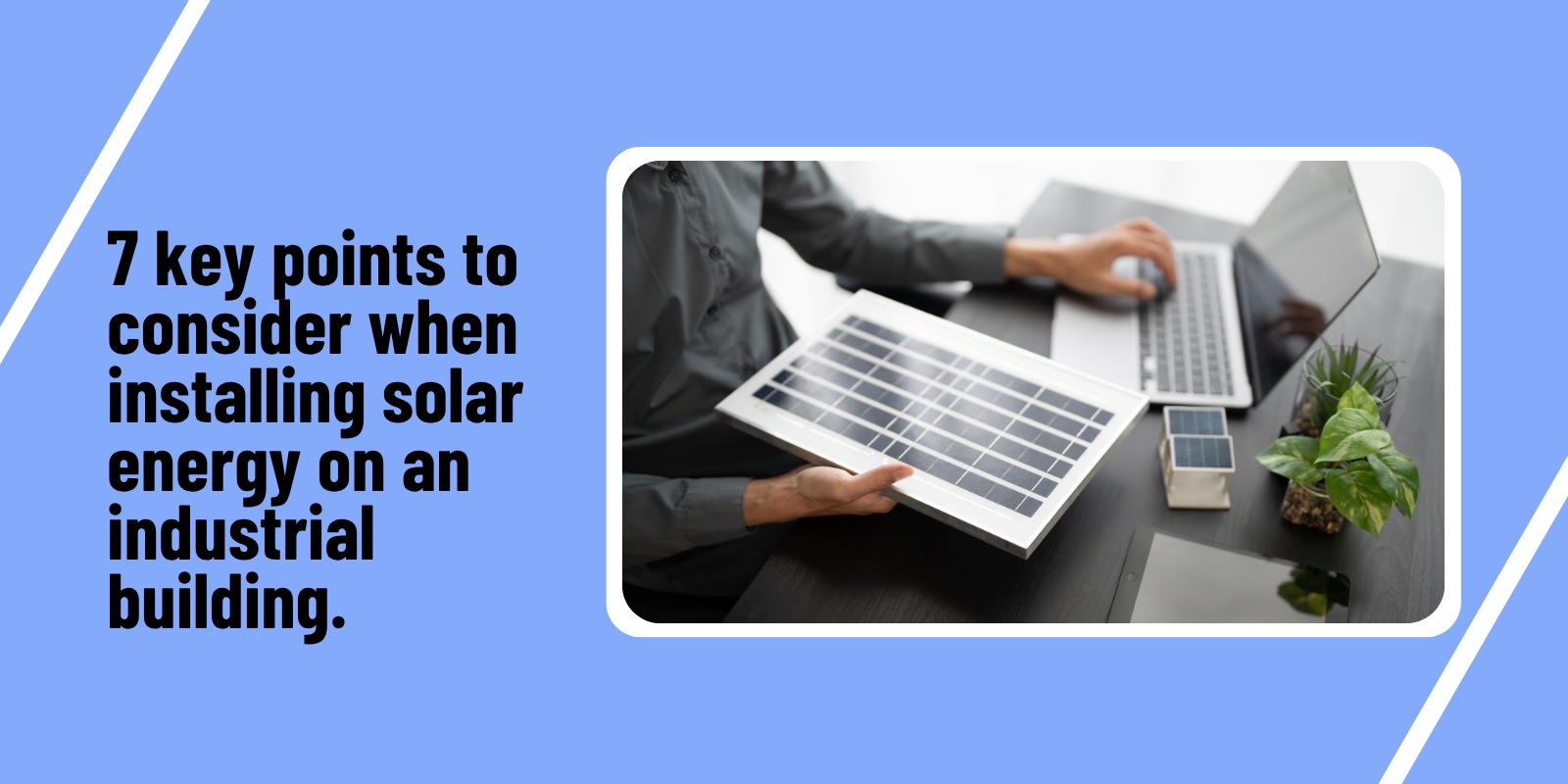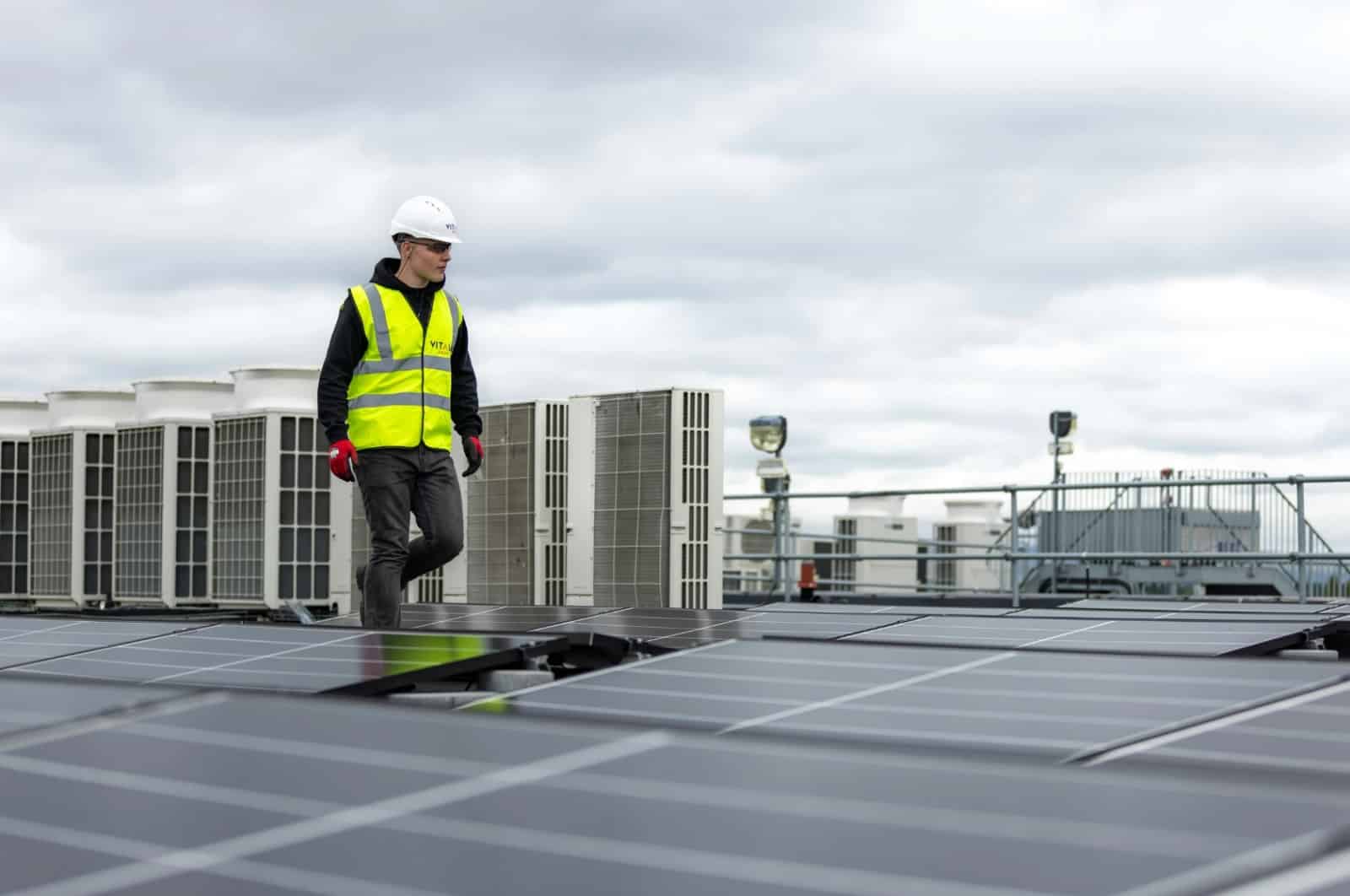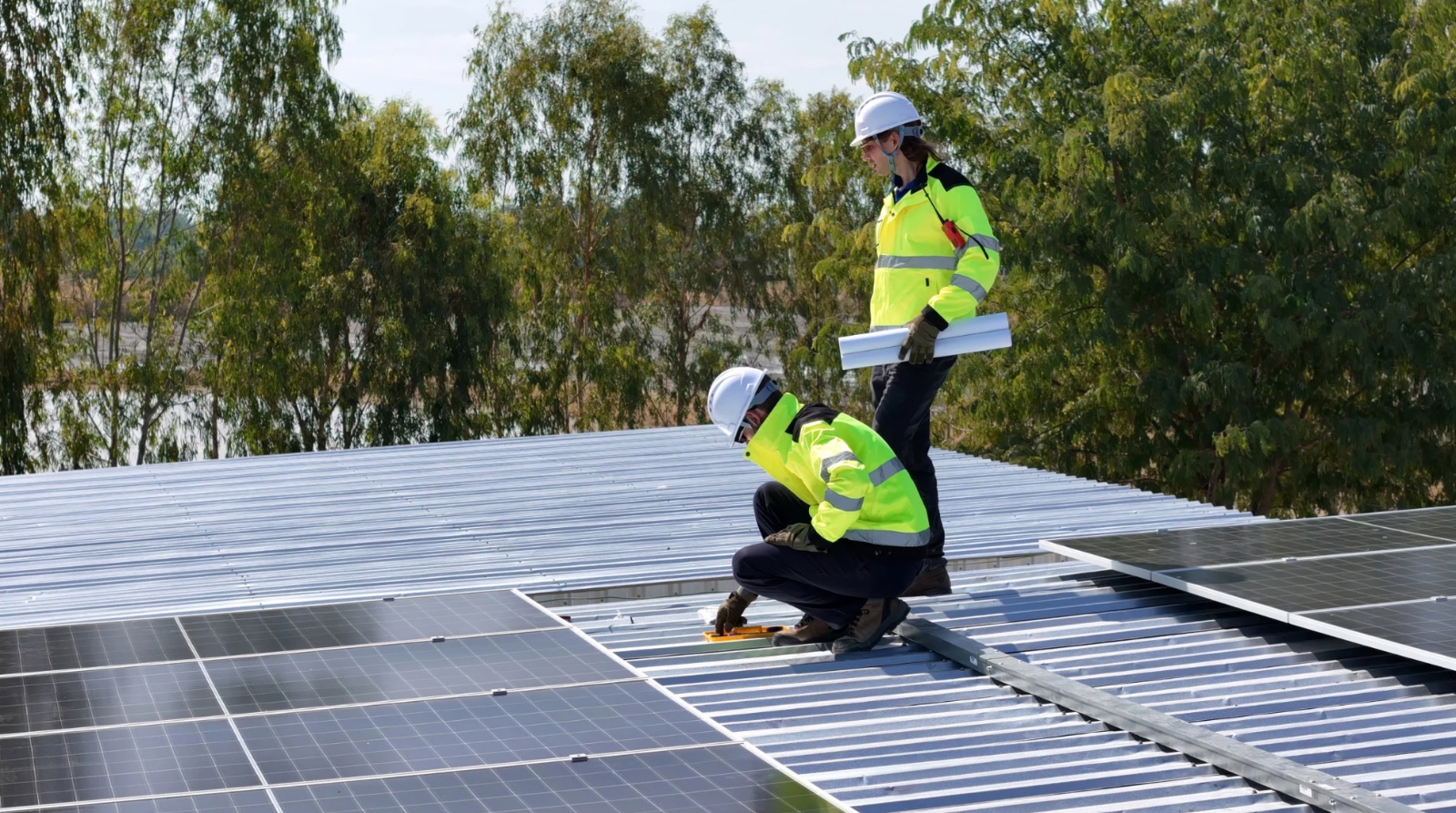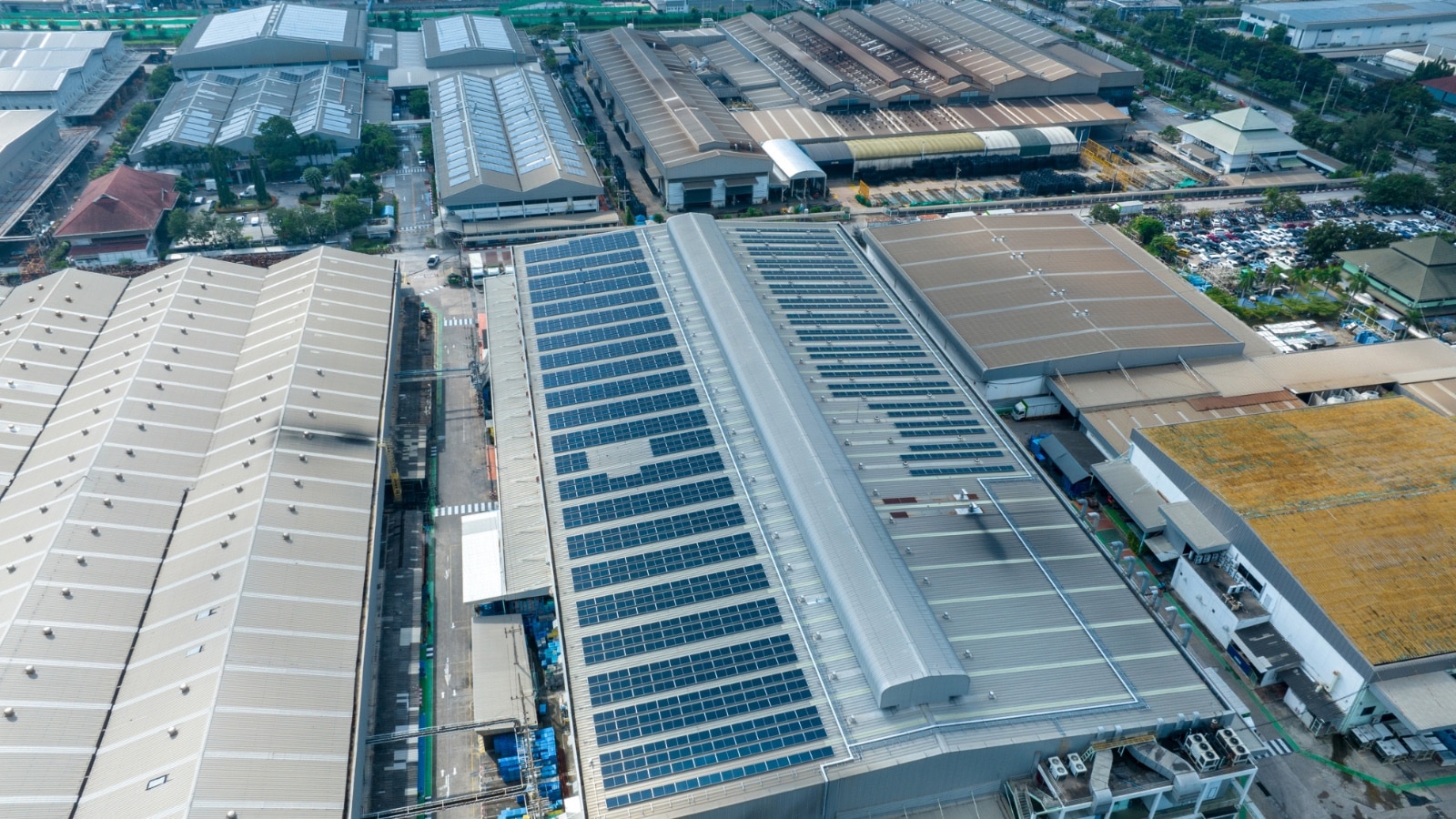
14 Oct 7 key points to consider when installing solar energy on an industrial building
Installing a solar panel on an industrial facility is an example of how solar installations have become one of the best investments for companies, as they not only significantly reduce operating costs but also improve corporate image and contribute to a greener future.
More and more industries, workshops, agricultural cooperatives, and warehouses are opting to install solar panels on their roofs, but there are key factors that must be analyzed because they can determine the success of the installation .

1. Initial evaluation: Consumption and feasibility of a solar installation in an industrial warehouse
The first and perhaps most important step is to thoroughly understand your electricity usage patterns, knowing when and how much you use . Analyze your electricity bills from the past 12 to 24 months to identify:
- Peak consumption: When do you use the most energy? During the day, at night, or on weekends?
- Baseline consumption: What is your minimum continuous consumption?
- Seasonal consumption: Does your consumption vary depending on the time of year?
This information is vital for correctly sizing the photovoltaic system and maximizing self-consumption, that is, the amount of solar energy you produce and use directly. At Gen Power, we conduct customized consumption studies to correctly size each installation.
2. Analysis of the Cover or Available Land
Before installing, check:
- Available space: Measure the usable area. Take into account obstacles such as skylights, extractor fans, or air conditioning units; consider whether the structure needs to be angled or can be
coplanar on the roof. - Roof orientation and pitch: In many cases, flat roofs or those with a slight southerly slope are the most suitable.
- Condition of the structure: A structural inspection is essential. Can the roof support the additional weight of the panels and their structure? Does it need prior repairs? A roof in poor condition could entail additional costs or even make the installation unfeasible: a load certificate from a structural engineer
is the most practical and reliable option. - Shadows from trees, buildings or chimneys that may reduce performance.
- Accessibility for maintenance and cleaning after solar installation in industrial warehouses.
- Land: If rooftop installation isn’t feasible, elevated structures or solar canopies are options. If you have adjacent land, this can be a viable alternative, offering greater flexibility in orientation and inclination.

3. Technical study and custom design of a solar installation in an industrial warehouse
A solar installation on an industrial building must be tailored to the structure of the building, actual consumption needs, projected growth, and roof characteristics. Proper sizing is key to optimizing the investment. A properly sized installation can reduce electricity bills by 40% to 70% and pay for itself in 3 to 6 years, depending on usage and available funding.
It is calculated according to:
- Power required (depending on consumption and surface area).
- Hours of sunshine available in the area. (Annual solar average).
- Current electricity rate type.
- Installation types: Grid-connected or off-grid. Depending on the location and consumption, you can opt for grid-connected self-consumption systems—which allow for the disposal of surpluses—or off-grid installations, which require storage batteries.
- In any case, the possible integration of batteries or shared consumption (several warehouses or departments) must be taken into account.
4. Return on Investment (ROI) and Financial Analysis
Before making a decision, perform a thorough financial analysis:
- Total project cost: Includes equipment, installation, permits, and possible structural reinforcements.
- Expected savings: Estimate how much you will save on your electricity bill annually.
- Payback period: Calculate how long it will take to recover your initial investment with the savings generated.
- System Lifespan: Solar panels typically have a lifespan of 25-30 years or more.
- Financing Options: Explore green loans or solar leasing if you don’t want a large initial investment.
5. Legal Framework and Permits
The installation requires the management of technical permits and licenses: technical report, construction permit, administrative and environmental authorizations, registration with the government, and a post-inspection prior to start-up. It is essential to inform yourself about state and regional incentives or subsidies before investing. Tax deductions and discounts on property tax (IBI) or property tax (IAE) may also be available in some municipalities.
6. Selection of Components and Suppliers for solar installation in an industrial warehouse
Before installing a solar panel on an industrial building, you must choose a professional, certified installer who guarantees safety, design quality, and a commissioning process that meets all legal and technical requirements.
The quality of the equipment and the experience of the installer are crucial to the durability and efficiency of a solar installation in industrial buildings.
- Solar panels: Research different technologies (monocrystalline, polycrystalline), product warranties, and performance.
- Inverters: They are the “brain” of the system. They consider efficiency, reliability, and functionalities such as monitoring.
- Mounting structures: They must be robust, corrosion-resistant and suitable for the type of roof.
- Storage Systems (Batteries): If your consumption is high at night or you want to maximize your independence from the grid, batteries may be an option, although they increase the initial investment.
- Installer: Choose a company with proven experience in industrial projects, good references, and a qualified technical team. Request several detailed quotes.
7. Maintenance and monitoring of a solar installation in an industrial warehouse
Like all solar installations, a solar installation in an industrial warehouse requires minimal preventative maintenance. It’s essential to schedule regular maintenance to ensure optimal performance and maximum savings, including periodic cleaning of the modules and inspection of wiring, connections, and structure.
Furthermore, today’s smart control systems allow you to know how much energy you produce, consume, and save, optimizing performance year after year. That’s why monitoring is so important, as it allows us not only to resolve issues but also to fine-tune our installation.

Conclusion
In short, installing a solar panel on an industrial building is a strategic and profitable decision that reduces costs and strengthens competitiveness and commitment to the future. However, it requires a comprehensive prior analysis, sound project planning, and a specialized installer to manage the entire technical and administrative process.
At Soma Gen Power, we carry out the technical analysis and help you analyze profitability, manage subsidies, and design the most efficient installation for your business.
Contact us and we’ll advise you without obligation.


No Comments